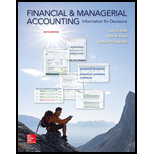
Concept explainers
Inventories:
Inventories are finished goods, work in progress and raw materials held by the company during its ordinary course of business and are intended to be sold or utilizing them for further production of goods and services.
Raw Material Inventory:
Raw material inventory refers to feedstock or components own by the producer which are yet to be utilized in the production of finished goods.
Work in Progress Inventory:
Work in progress inventory represents the inventory which is undergoing the production process or partially completed units.
Finished Goods Inventory:
Finished goods inventory is the stock of goods which are fully processed or manufactured and also include goods purchased in a fully complete form. Finished goods inventory forms that part of the inventory which is utilized to fulfill the customer’s orders.
To identify: Titles and amounts of inventory components of the Company D.
Want to see the full answer?
Check out a sample textbook solution
Chapter 14 Solutions
Financial and Managerial Accounting: Information for Decisions
- Ginga Marketing Group is a digital marketing business. At the end of its accounting period, December 31, 2023, Ginga had assets of $875,000 and liabilities of $320,000. Determine the net income (or loss) during 2024, assuming that as of December 31, 2024, assets were $960,000, liabilities were $290,000, and no additional capital stock was issued or dividends paid.arrow_forwardSara Manufacturing has an asset with an original basis of $45,000, and depreciation has been claimed in the amount of $27,000. If the asset's adjusted basis is $28,000, what is the amount of capital improvements that have been made to the asset? A. $8,000 B. $10,000 C. $18,000 D. $25,000 E. None of these choices are correct.arrow_forwardI am looking for help with this general accounting question using proper accounting standards.arrow_forward
- I need help finding the accurate solution to this financial accounting problem with valid methods.arrow_forwardXabier Retail's retained earnings increased from $185,000 on January 1 to $257,500 on December 31. During the year, the company paid dividends of $42,000 and issued new common stock worth $65,000. What was Xabier Retail's net income for the year?arrow_forwardaccounting question?arrow_forward
- Can you show me the correct approach to solve this financial accounting problem using suitable standards?arrow_forwardCan you help me solve this financial accounting problem using the correct accounting process?arrow_forwardPlease provide the accurate answer to this general accounting problem using valid techniques.arrow_forward
- Can you explain this general accounting question using accurate calculation methods?arrow_forwardI need assistance with this general accounting question using appropriate principles.arrow_forwardLinnea Retail Services experienced an increase in retained earnings of $47,900 from September 30 of year 1 to September 30 of year 2. A cash dividend of $18,200 was declared and paid during the year. Compute the net income for the year.arrow_forward

 AccountingAccountingISBN:9781337272094Author:WARREN, Carl S., Reeve, James M., Duchac, Jonathan E.Publisher:Cengage Learning,
AccountingAccountingISBN:9781337272094Author:WARREN, Carl S., Reeve, James M., Duchac, Jonathan E.Publisher:Cengage Learning, Accounting Information SystemsAccountingISBN:9781337619202Author:Hall, James A.Publisher:Cengage Learning,
Accounting Information SystemsAccountingISBN:9781337619202Author:Hall, James A.Publisher:Cengage Learning, Horngren's Cost Accounting: A Managerial Emphasis...AccountingISBN:9780134475585Author:Srikant M. Datar, Madhav V. RajanPublisher:PEARSON
Horngren's Cost Accounting: A Managerial Emphasis...AccountingISBN:9780134475585Author:Srikant M. Datar, Madhav V. RajanPublisher:PEARSON Intermediate AccountingAccountingISBN:9781259722660Author:J. David Spiceland, Mark W. Nelson, Wayne M ThomasPublisher:McGraw-Hill Education
Intermediate AccountingAccountingISBN:9781259722660Author:J. David Spiceland, Mark W. Nelson, Wayne M ThomasPublisher:McGraw-Hill Education Financial and Managerial AccountingAccountingISBN:9781259726705Author:John J Wild, Ken W. Shaw, Barbara Chiappetta Fundamental Accounting PrinciplesPublisher:McGraw-Hill Education
Financial and Managerial AccountingAccountingISBN:9781259726705Author:John J Wild, Ken W. Shaw, Barbara Chiappetta Fundamental Accounting PrinciplesPublisher:McGraw-Hill Education





